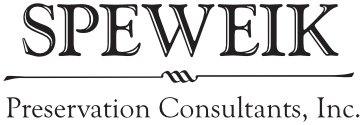Training – Lime Putty Mortar – 34th District Courthouse, Chalmette, LA
Project certificate training according to ASTM E2659-18 for the masons involved in the historical restoration of the limestone facade masonry on the 34 District Courthouse in Chalmette Louisiana
Training – Substitute Stone Repair
Historic Masonry Training in Substitute Stone Repair at the University of Wisconsin, North and South halls ca. 1849.
Training – DHL Dispersed Lime Injection
ASTM E2659-18 Historic Masonry Training Component No. 6 DHL Lime Crack Injection
Training – Remove and Replace Historic Stone
Project certificate training for historic masonry Division 4 according to ASTM E2659-18. North and South Halls at the University of Wisconsin, circa. 1849
Training – Dutchman Stone Repair
Dutchman stone repair training according to ASTM E2659-18 for the masons on the MIT pilot project in Cambridge, MA. The training involved careful removal of deteriorated stone and poor previous repairs and replacement with true Dutchman style stone repairs.
MIT Moisture Sensor Installation – Historic Masonry Technology
Installation of moisture sensor technology to better understand the dynamics of the historic masonry limestone facade at the Main Group Buildings at the Massachusetts Institute of Technology in Cambridge, Massachusetts.
SPC Historic Stone Masonry Training – Remove, Redress and Return
Speweik Preservation Consultants were commissioned to create, design, and implement an onsite training program that met with the requirements of the new ASTM E2659-18 Standard. The training involved working with the masons, architect, building owners and general contractor as well as the state historic preservation office to ensure all stone treatments complied with the Secretary ...
Carthalite Restoration – Minisa Bridge, circa 1932
CARTHALITE PRESERVATION Minisa 13th Street Bridge, Wichita, Kan Rehabilitation of the Minisa 13th Street bridge in the heart of Wichita Kansas was a community undertaking that entailed the efforts of many dedicated people, contractors, agencies and even the governments of foreign countries. Part engineering part artistic sculpture, no where in the Midwest is there such ...
